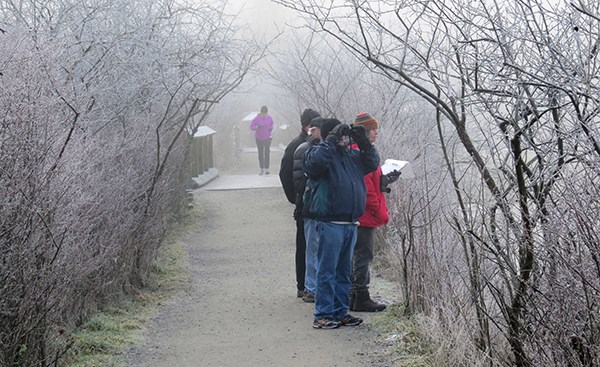Foggy weather hampered visibility for this year’s Christmas Bird Count but volunteers were still able to collect valuable data for the Tri-Cities, according to SFU ecologist John Reynolds.
While the figures are still being tallied, 75 volunteers broken up into 15 teams identified a total of 8,000 birds from 75 species during the annual bird census, numbers that are lower than average. At times it was possible to hear some of the birds, Reynolds said, but the low fog made them difficult to spot.
“We knew they were out there,” he said, “we just couldn’t see them.”
Still, Reynolds notes that a one-year snapshot does not tell scientists much about the local bird population and the statistics need to be interpreted in a larger context.
The Tri-Cities are just one of more than 2,000 places across North America where the Christmas count takes place, with all of the data being sent to the Audubon Society, which uses it to track migration and species variation.
The Burke Mountain Naturalists have ran the count in Coquitlam, Port Coquitlam and Port Moody for more than 20 years, with noticeable changes occurring over that time. For example, the number of species spotted in the area has risen dramatically, from a low of 40 in 1995 to an average of 84 in the last few years.
Reynolds said that warmer winters are likely the reason for the increase in variation, with many birds managing to find food sources throughout the cold months.
“Milder winters benefit the number of species,” he said. “The cold snap that we experienced for the week or so before the count undoubtedly caused a few lingering species to move further south.”
One bird that was non-existent in the area during the winter months but has started popping up during the Christmas counts is the Anna’s hummingbird. Volunteers spotted 38 last year and 30 this year due to the fog, with the increase from earlier days of the count attributed to milder temperatures and bird feeders being left out year-round, Reynolds said.
The Rufus hummingbird, another common sight during the summer months, has also been popping up in the data for the winter counts.
“A lot of people are surprised to think a tiny bird like that, which needs high-energy food to survive, can survive in the winters,” Reynolds said. “Frankly, so am I. But they are here with us to stay as long as the mild winters stay with us.”
More than 100 years ago, it was a Christmas tradition in some parts of North America to go outside and shoot as many birds as possible. But as the bird population shrank and people became more environmentally aware, they began to count the birds instead of kill them.
The Audubon Society took up the initiative, keeping track of the data from across North America and parts of Central America, collected during the various counts.
“They have been going on for 100 years,” Reynolds said. “They provide an unprecedented series of counts done in a standardized way that allows you to analyze trends over time.”
Participating in the counts is also a fun way to get to know other birders, Reynolds said, and get outdoors for a few hours over the holidays.
• John Reynolds will be presenting an overview of the data collected from this year’s bird count at the next Burke Mountain Naturalists meeting on Jan. 12 at 7:30 p.m. at Como Lake United Church. Members of the public are welcome to attend. More details, see page 27.
XMAS BIRD COUNT
YEAR TOTAL
2015 8,500
2014 11,500
2013 8,500
2012 7,100
2011 10,000
2010 8,700
2009 6,400
@gmckennaTC



